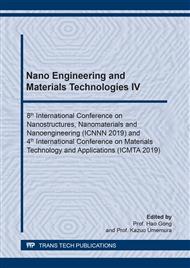p.239
p.244
p.250
p.256
p.262
p.267
p.272
p.277
p.283
The Effect of Thermal Aging on Mechanical Properties and Morphological Properties of Thermoplastic Vulcanizates Based on Natural Rubber and Polystyrene
Abstract:
Thermoplastic vulcanizates or TPVs is a type of materials exhibiting excellent properties between thermoplastic and elastomer by combining the characteristics of vulcanized rubber with the processing properties of thermoplastics. This research aims to study the effect of thermal aging on the morphology and mechanical properties of thermoplastic vulcanizates (TPVs) based on a mixture of natural rubber (NR) and polystyrene (PS). TPVs samples were prepared using the internal mixer at a mass ratio of NR/PS 70/30, 50/50, 30/70 and 0/100. Tensile properties and impact strength showed that when the amount of NR increased tends of impact strength and elongation at break increased but tends of tensile strength decreased. On the other hand, tends of tensile strength for thermal aging at 70°C for 3 days increased when the amount of PS increase. The blending ratio of NR / PS at 70/30 is the best. It gave a worthy increase from 19.94 MPa to be 25.56 MPa (28.18%).
Info:
Periodical:
Pages:
262-266
Citation:
Online since:
May 2020
Keywords:
Price:
Сopyright:
© 2020 Trans Tech Publications Ltd. All Rights Reserved
Share:
Citation:


